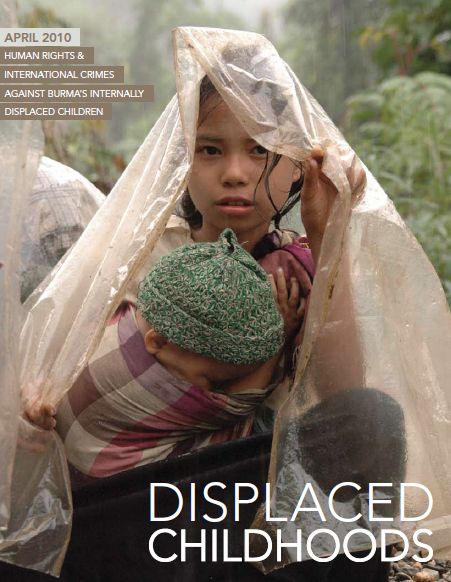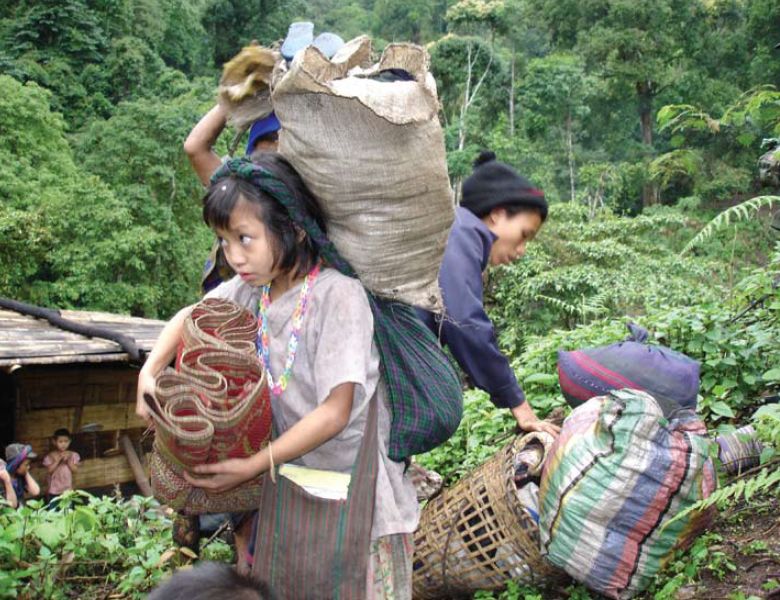 Report documents firsthand testimonies of the abuses faced by internally displaced children in SPDC relocation sites, in ceasefire areas, and in hiding.
Report documents firsthand testimonies of the abuses faced by internally displaced children in SPDC relocation sites, in ceasefire areas, and in hiding.
Living on the way
As many as 330,000 to 990,000 children live in internal displacement in Burma. Generations of children in Burma have grown up surrounded by tragedy, violence, poverty, and destruction, only to witness their own children endure the same experiences. Despite the scale and protracted nature of this crisis, information on the plight of internally displaced children in Burma rarely reaches the outside world.
Restrictions on travel and movement imposed by the regime, general inaccessibility of areas of the country where internally displaced persons (IDPs) live, particularly in the conflict zones of eastern Burma, and the constant movements of IDPs obstruct the availability of information on IDPs. The struggles and hardships of internally displaced children in Burma often occur in silence.
Lack of protection
Partners and FBR have documented in this report the lack of protection and impact of internal displacement on children to bring attention to this particularly marginalized population and call for a meaningful international response.
This report examines the ongoing internal displacement of children in Burma, including the causes and patterns of internal displacement; the impact internal displacement has on Burma’s children; and Burma’s legal obligations under domestic law as well as international human rights, humanitarian law, and criminal law to protect and provide for internally displaced children.
It documents and represents hundreds of firsthand testimonies of mothers, fathers, and children from Burma who are currently living as IDPs or have lived in displacement settings. A set of recommendations are provided to the military government of Burma, the agencies and officials of the United Nations (UN), and the international community.
International law prohibits forced displacement of civilians
As a member of the UN and a party to the UN Convention on the Rights of the Child (CRC), the Convention on the Elimination of All Forms of Discrimination against Women (CEDAW), and the Geneva Conventions I, II, and III of 1949, Burma is bound by international human rights and humanitarian law.
Under international law, forced displacement of civilian populations is prohibited. According to the UN Guiding Principles on Internal Displacement (which define international standards relating to internally displaced persons (IDPs) on the basis of international humanitarian, human rights, and refugee law) national authorities are responsible to “prevent and avoid conditions that might lead to displacement of persons.”
prohibited. According to the UN Guiding Principles on Internal Displacement (which define international standards relating to internally displaced persons (IDPs) on the basis of international humanitarian, human rights, and refugee law) national authorities are responsible to “prevent and avoid conditions that might lead to displacement of persons.”
Far from fulfilling its obligations under international law, Burma’s military regime is largely responsible for much of the displacement that occurs in Burma. Callous actions and deliberate policies of the regime have led to violent attacks on civilians, irresponsible development projects, widespread human rights abuses, unspeakable poverty, and general insecurity, which have resulted in new instances of displacement throughout the country.
112,000 villagers displaced in 2009
In 2009 alone, the military regime was responsible, directly or indirectly, for the displacement of some 112,000 villagers in eastern Burma. Of those displaced, children are particularly at risk.
The CRC, which Burma acceded to in 1991, not only protects a child’s inherent right to life, but also requires States Parties to “ensure to the maximum extent possible the survival and development of the child.” Article 16 of the CRC further prohibits arbitrary or unlawful interference with a child’s home and extends the right of protection against such interference. Further protections ensure children have access to “the highest attainable standard of health,” an adequate standard of living, an education, and numerous other basic rights and freedoms.
Despite such provisions, children in Burma are not immune to government-sanctioned abuse. This report documents how childhood is often disrupted by violence, insecurity, and poverty. Children are witnesses of and subject to arbitrary and extrajudicial killings, torture and mistreatment, arbitrary arrest and detention, rape and sexual violence, forced labor and portering, recruitment as child soldiers, and restrictions on basic and fundamental freedoms. They are inordinately affected by the rampant poverty, inadequate schools, and poor healthcare that exists in Burma.
Uncertain childhood
While nearly all children in Burma are affected to some extent by insecurity, poverty, and lack of adequate social services, internally displaced children face particularly extreme and appalling conditions in displacement settings. This report documents how IDPs are typically forced to leave their villages, homes, farms, and livelihoods with very little advanced warning. Often they are only able to take with them what they can carry and sometimes not even that.
 They find themselves in precariously unstable circumstances, lacking protection from human rights violations committed by the Burma Army and in danger of further displacement with little access to the most basic necessities, including adequate and sustainable food sources, clean drinking water, stable shelters, schools, and healthcare facilities. For internally displaced children in Burma, childhood is full of uncertainty and insecurity.
They find themselves in precariously unstable circumstances, lacking protection from human rights violations committed by the Burma Army and in danger of further displacement with little access to the most basic necessities, including adequate and sustainable food sources, clean drinking water, stable shelters, schools, and healthcare facilities. For internally displaced children in Burma, childhood is full of uncertainty and insecurity.
Based on the incidents documented in this report, it is clear that the SPDC is in contravention of its legal obligations under international humanitarian and human rights law.
Considering the nature and scale of displacement in Burma, the SPDC’s actions may also amount to more extreme violations, including crimes against humanity and war crimes. While the wounds inflicted by the SPDC will take many generations to heal, before the healing process can begin those responsible must be brought to justice and held accountable for their actions.
Report
Partners, FBR and Norwegian Burma Committee want this report to bring the truth of what is happening to children inside Burma to the international community. Download your copy now here.
Contacts
For more information on the report and for details on supporting advocacy activities in your country, please email info@partnersworld.org.nz
 Partners Relief & Development is a registered Christian international relief and development agency in Australia, Canada, New Zealand, Norway, the United Kingdom and the United States, established in 1995. The organization assist those, especially children, who are affected by war and now living in hide sites in Burma’s conflict zones, and refugee camps and migrant communities along the Thai-Burma border. Partners help with nutrition, medical, educational and spiritual care.
Partners Relief & Development is a registered Christian international relief and development agency in Australia, Canada, New Zealand, Norway, the United Kingdom and the United States, established in 1995. The organization assist those, especially children, who are affected by war and now living in hide sites in Burma’s conflict zones, and refugee camps and migrant communities along the Thai-Burma border. Partners help with nutrition, medical, educational and spiritual care.
 The Free Burma Rangers is a multi-ethnic humanitarian service movement. Ethnic pro-democracy groups send teams to be trained, supplied and sent into the areas under attack to provide emergency assistance and human rights documentation. Together with other groups, the teams work to serve people in need.
The Free Burma Rangers is a multi-ethnic humanitarian service movement. Ethnic pro-democracy groups send teams to be trained, supplied and sent into the areas under attack to provide emergency assistance and human rights documentation. Together with other groups, the teams work to serve people in need.
Related links:
Karen Communities Worldwide call for action to stop attacks on civilians
Burma urged to end repression of ethnic minorities before elections


